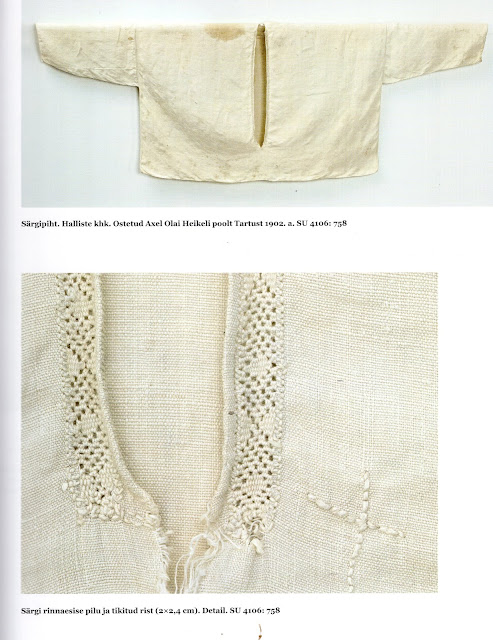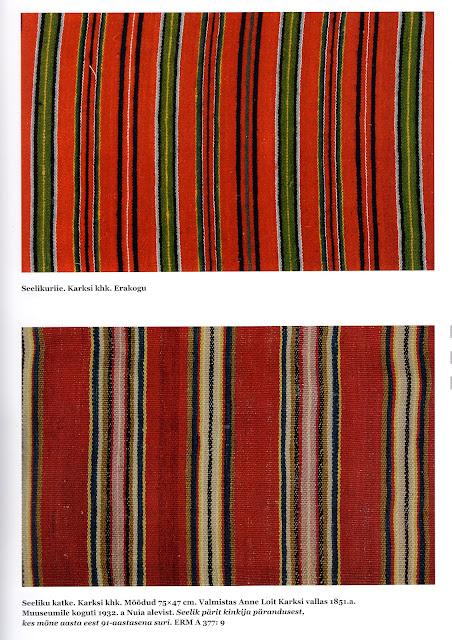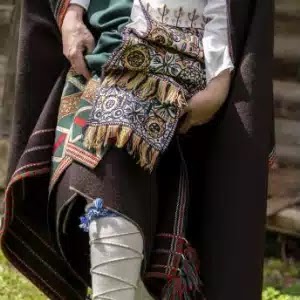Hello all,
Today I would like to continue my survey of the Folk Costumes and Embroidery of the South Estonian ethnicity by looking at Mulgimaa.
The Mulgi region traditionally consists of the five parishes of Helme, Karksi, Tarvastu, Paistu and Halliste, as well as the southern parts of Viljandi parish, and the eastern parts of Saarde parish. Here is a map of the approximate extent of this region.
This area was more important historically, but today is not recognized politically, although it does have a flag. Mulgi folk culture is still very alive, and distinct from that of the rest of Estonia. [The following article is in Estonian, but one can click on the translate icon at the top]
The attire is similar to that of other parts of South Estonia, but this region is characterized by the retention of some very archaic costume pieces and styles of embroidery, with much emphasis on solar motifs.
The image at the head of the article shows many of these archaic features. The outfit shown is from the parish of Halliste.
There are two somewhat different variants of this costume, one being found in the two western parishes of Halliste and Karksi, and the other in the three eastern parishes of Paistu, Tarvastu and Helme.
The chemise, särk, had a rather archaic cut.
The neck opening and cuffs were ornamented with hemstitching, often the lower part was made of a coarser linen.
The simplest was a rectangular piece of cloth ornamented with a narrow polychrome braid sewn around the edges and held in place by a pick-up woven sash around the waist. This might be made in natural dark wool, or dyed red for younger women.
A wrap skirt for dress might be made in white wool with solar motifs embroidered around the hem and the end which is exposed when wrapped.
The red or dark wool variants may be ornamented with bronze wire and/or silver plates. This is an older variation, but examples still exist.
Later the skirts were woven with stripes or plaids, sewn into a waistband, and came to resemble those of other parts of South Estonia.
Hip aprons, puusapõll, are an ancient Uralic garment, surviving into the near present in Estonia only in Setumaa and Mulgimaa. The present theory is that this garment covered the opening of the wrap skirt on the left side.
These seem to be of white wool or linen with solar and cross motifs embroidered on the ends, which also had fringes. The color palette is reminiscent of Latvian embroidery, found just to the south. Note that the red in the older examples has faded.
The front apron, põll was a later addition to the attire of this region, adapted from outside. One distinctive version of the apron in this region was of green cloth, ornamented with ribbon and galloon. This was worn with or without the hip apron.
The sash, vöö, is woven with pick-up designs, and resembles those of other parts of Estonia, and indeed, of eastern Europe. They hold the lower body garments in place, and ornament the waist, as well as providing both physical and spiritual protection. A good vöö wraps around the waist at least twice.
For dress, white knitted stockings, suka, with a narrow band of knitted in ornament were worn with moccasins, pastlad. The stockings would be held up by woven or plaited garters. In summer, people often went barefoot.
Married women put their hair up and covered it with a simple white piece of cloth, pearäti, tied at the back of the head. The woman in this first image has left her hair down, which is incorrect.
Jewelry consisted of annular brooches, silver chains and rings, and necklaces of hollow silver beads or amber.
There is one surviving example of a silver belt that was apparently worn over a long white linen headdress.
Shoulder wraps were common here, as elsewhere in the Baltics. They could be of white wool with solar motif embroidery,
Dark wool embellished with cord,
Sheepskin overcoats were likely worn here, but I have not found any images from this region specifically.
Knitted mittens are popular here, as everywhere in the Baltics, though they seem to be mostly black and white in this region. They were worn not only for warmth, but to show off the expertise of the maker, or the gifter.
Men's clothing consisted of a shirt, similar in cut to the woman's chemise, but shorter. Likewise ornamented with hemstitching, but less extensively.
Dark wool knitted stockings, held up by woven or plaited garters.
Silver annular brooches were worn to close the neck opening of the shirt. Silver rings and buttons might be worn as well.
The ensemble was completed with a leather belt, a leather waist bag, a felt hat, and mittens and dark wool overcoat similar to those of the women. The mittens were usually a gift from a significant female in his life; mother, sister, wife or girlfriend. The overcoat was closed with a wide inkle woven sash. This first image is odd, I would expect the stockings to be worn over the pants, as in other parts of South Estonia.
Perhaps you could find a use for this embroidery in your own life.
Roman K.
email: rkozakand@aol.com
Source Material:
Tiina Jürgen, 'Mulgi Rahvarõivad', Viljandi, 2015
Reet Piiri, 'Suur Mutsiraamat', Healugu, 2017
Eevi Astel, ';Eesti Võõd', Tartu, 1998
Reet Piiri, 'Eesti Talurahva Ülerõivas 19. sajandil' Tartu, 2007
Melanie Kaarma et al, 'Eesti Rahvarõivad' Tallinn, 1981
V. Belitser et al, 'Eesti Rahvarõivad XIX Sajandist ja XX Sajandi Algult', Tallinn, 1957
Maret Tamjärv, 'Eesti Rahvarõivad', Tallinn, 2001
A. Üts et al, 'This Beautiful Land is my Native Country', UNRRA, 1946
Reet Piiri, 'Rahvarõivad Eesti Rahva Muuseumist', Tallinn, 2006
Reet Piiri, 'Rahvarõivas on Norm', Tartu 2002































































































.webp)






































.webp)




.webp)













